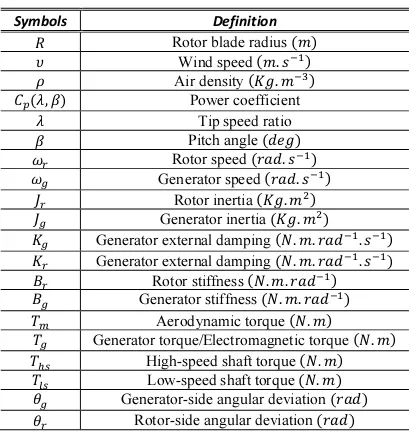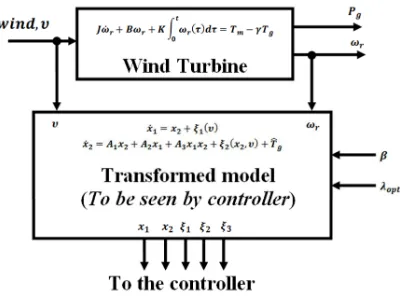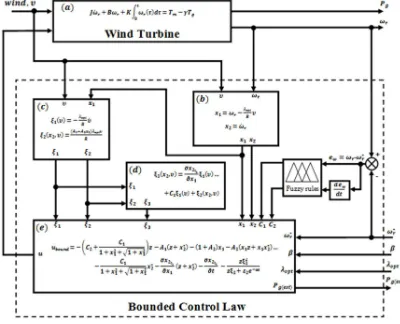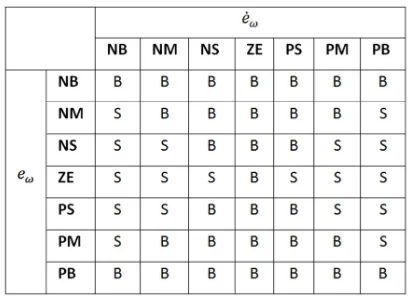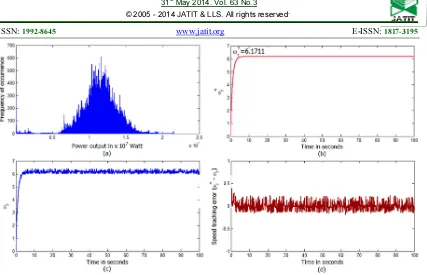ISSN: 1992-8645 www.jatit.org E-ISSN: 1817-3195
ROBUST BOUNDED CONTROL FOR UNCERTAIN
NONLINEAR SYSTEMS: APPLICATION TO A NONLINEAR
STRICT FEEDBACK WIND TURBINE MODEL WITH
EXPLICIT WIND SPEED DYNAMICS
1MUHAMMAD NIZAM KAMARUDIN, 2ABDUL RASHID HUSAIN, 3MOHAMAD NOH
AHMAD
1
Faculty of Electrical Engineering, Universiti Teknikal Malaysia Melaka (UTeM), 76100 Durian Tunggal, Melaka, Malaysia
2,3
Faculty of Electrical Engineering, Universiti Teknologi Malaysia, UTM Skudai, 81310 Johor, Malaysia
E-mail: [email protected], [email protected]
,
3ABSTRACT
In this paper, a robust bounded control law for a class of uncertain nonlinear systems is proposed. The proposed bounded controller guarantees asymptotic stability, asymptotic tracking and asymptotic disturbance rejection of systems in strict feedback form with the sum of unmatched uncertainties and the unbounded exogenous disturbance. A feedback law emerged from Artstein's Theorem and Sontag's universal formulas are known to be useful to limit the control signal. However, the formulas are not robust as in many cases, being applied to the systems without uncertainties and disturbances. The controller proposed in this paper takes advantages of a mixed backstepping and Lyapunov redesign, which employed to enrich the Sontag's universal formulas. Therefore, the appealing feature of the proposed controller is that it satisfies small control property in order to preserve performance robustness and stability robustness with less control effort. Another advantage of the proposed controller is the formulas become applicable to higher order systems (i.e. order > 0). This paper also discusses fuzzy logic tuning approach for the controller parameters such that the closed loop system matrix remain Hurtwitz. For practicality, the proposed technique is applied to a variable speed control of a new strict feedback wind turbine system with wind dynamics appeared explicitly in the system model. The proposed controller guarantees the asymptotic tracking of the turbine rotor speed; maintains the optimal tip speed ratio and produces maximum power coefficient. This yields maximum power output from the turbine.
Keywords:Robust bounded control, wind turbine, asymptotic tracking, Backstepping, Lyapunov function
1. INTRODUCTION
Stabilizing nonlinear systems with uncertainties and exogenous disturbances requires massive control energy. For linear systems, a traditional and classical approach to avoid excessive control effort is the anti-windup scheme. Anti-windup scheme has no standard design procedure. Principally, anti-windup compensator is augmented to the nominal controller to avoid integral controller from windup during control input saturation. This scheme is surveyed in [1-3]. Obtaining fast convergence of the systems' states to equilibrium points also require massive initial control inputs. As such, one may also consider bounded control problem as an optimal control problem in which, the control input has to be limited within admissible set of inputs. However, optimal control problem such as linear
quadratic regulator and linear quadratic Gaussian are only useful to design linear controllers for linear systems [1, 4]. In linear systems, input/output frequency domain methods are known to be effective. However, nonlinear systems are unpredictable and solving them requires more advance mathematics. In nonlinear systems, poles and zeros, frequency domain, phase and gain margin are not defined. Linearization of nonlinear systems are normally obtainable by using the Jacobian at equilibrium points, afterward, simple linear controller can be applied to achieve stabilization. However, the controller will not be able to guarantee stabilization beyond wide range of nonlinear sector. For instance, nonlinear system
ISSN: 1992-8645 www.jatit.org E-ISSN: 1817-3195
would obtain x y , y y x for simplicity. However, a control law designed using linearized model would not be robust within the wide range of operation.
For nonlinear systems, the Lyapunov function is a general tool for stability and robustness analysis. Nonlinear systems, contrasting linear systems, require more treatment from nonlinear controllers such as the one proposed in this paper - a backstepping and Lyapunov redesign technique. However, need to limit the control signal may offers some additional method to be pondered. In this paper, Sontag universal formulas [5-6] that mainly reported for systems without uncertainties are embedded with Backstepping and Lyapunov redesign, in order to obtain the asymptotic stability and the asymptotic disturbance rejection with less control effort. Theoretical background on backstepping technique can be reviewed in [7-9]. Theoretical background on mixed backstepping and Lyapunov redesign can be reviewed in [10-12].
In this paper, the robust bounded control law is designed to construct a variable speed control for a wind turbine system. Focuses of this paper are (Obj.1): to introduce a new wind turbine model so called a strict feedback wind turbine model. (Obj.2): to design robust controller in order to achieves asymptotic tracking of the rotor speed, to guarantees asymptotic disturbance rejection toward unmatched uncertainties cum unbounded exogenous disturbances and to obtain maximum generated output power, and (Obj.3): to introduce a bounded control law in order to reduce the energy consumed by the controller, to reduce high magnitude sparking in the control signal and to reduce the oscillation in the control signal. For typical wind turbine systems, the rotor speed is depending solely on the blade radius, the tip speed ratio and the wind speed. Hence, to fulfill objective (Obj.1), the rotor speed and its derivative are respectively transformed into a single variable (for instance, x and x). This leads to the second order strict feedback wind turbine model with the sum of unmatched uncertainties and the unbounded exogenous disturbance. Based on this model, the stabilization of x and x in its equilibrium may results in the asymptotic tracking of the rotor speed and asymptotic disturbance rejection toward the sum of unmatched uncertainties and the unbounded exogenous disturbance. Upon achieving the asymptotic tracking of the rotor speed, the maximum power output from the wind turbine may be guaranteed as a result of the optimum tip speed ratio and the maximum power coefficient. Hence,
this fulfills objective (Obj.2). The control algorithm in (Obj.2) is improved using mixed Sontag formulas, backstepping and Lyapunov redesign in order to limit the control magnitude, to reduce distortion and to reduce high frequency oscillation.
2. WIND TURBINE SYSTEM
This section discuses wind turbine system that consists of rotor model and aero-turbine model. Table 1 tabulates wind turbine parameters for the
Generator torque/Electromagnetic torque .
௦ High-speed shaft torque .
௦ Low-speed shaft torque .
Generator-side angular deviation
Rotor-side angular deviation
2.1 Rotor Model
Wind turbines work by converting the kinetic energy from the wind into rotational energy in the turbine. The rotational energy is then converted into electrical energy. The aerodynamic power produced by the turbine can be expressed as [13-19]:
power produced by the wind, and
(2)
ISSN: 1992-8645 www.jatit.org E-ISSN: 1817-3195
2.2 Aero-turbine Model
Figure 1: Two-mass wind turbine structure as appeared in [13, 17-18] emerged from the turbine structure which impose a gear box that separates a low-speed mechanical dynamic and a high-speed mechanical dynamic. The torque produced by the turbine can be developed as:
(3)
The transmission output torque:
(4)
The gearing ratio is denoted as:
where the lumped system parameters are defines as:
(7)
(8)
(9)
Universally accepted two-mass wind turbine model in Eq. (6) (also appeared in [13, 17-18]) does not consider wind dynamics explicitly in the system model. This is because of that wind dynamics are non-deterministic, having chaotic behavior and highly nonlinear in nature. As such, in this paper, wind dynamics are considered explicitly in the system model. This approach replenishes wind speed fluctuation in the wind turbine model which behaves as an exogenous disturbance to the system. As a modeling result, wind turbine model in this paper is represented in its new form so-called a strict feedback wind turbine model, that is required for practicality and actual application. Strict feedback form also smoothes the design progress of a backstepping and Lyapunov redesign concept that will be discussed thoroughly in what follows.
The aerodynamic torque applied to the hub of the wind turbine can be expressed as
Differentiating both sides of Eq. 10 yields:
Note that an optimum tip speed ratio yields the maximum power coefficient . Thus, and induce the maximum output power . Defining ≡
ISSN: 1992-8645 www.jatit.org E-ISSN: 1817-3195
This implies that the 2nd-order strict feedback wind turbine model, becomes: Smooth function is an unbounded exogenous disturbance constituting wind speed fluctuation. While the smooth function , is the sum of unmatched uncertainties and the unbounded exogenous disturbance. A combination of Eq. (16) and Eq. (17) behaves as a transformed wind turbine model, which is useful for controller design. Figure 2 depicts the model configuration.
Figure 2: Model configuration - for controller design
3. CONTROLLER DESIGN 3.1 Power Coefficient
The power coefficient is a unique nonlinear function that depends on turbine types
[20]. As such, the value of is provided via look-up-table by each turbine manufacturer. On the other hand, the power coefficient can be expressed by a typical empirical formulas (for instance, see [20-21]). In [20], the power coefficient model is
Figure 3 shows power coefficient characteristic for various . For a regulated pitch angle at 0°, one may obtain the expression for power coefficient as:
0.5 % 0.0001 9.06* +116
.. (20)
Then, the optimum tip speed ratio
7.953925991 yields the maximum power
coefficient 0.4109631031. Both
$ % are treated as a reference values and are embedded in the control algorithm.
Figure 3: Power coefficient characteristic
3.2 Normal Variable Speed Control Design
Initially, by using normal backstepping and Lyapunov redesign technique, two-mass strict feedback wind turbine system in Eq. 16 and Eq.
ISSN: 1992-8645 www.jatit.org E-ISSN: 1817-3195
turbine subsystem in Eq. 16 is obtained. One may observe that the unforced autonomous-like wind turbine subsystem in Eq. 16 can be stabilized by a simple continuously differentiable feedback control law:
; ∀ 1 0 (21)
Without loss of generality, one may also consider a continuous function 0 0 as a desired
such that the closed-loop nominal subsystem
is asymptotically stable. Therefore, there negative definite. This imposes that the unwanted energy subjected by the inertia, stiffness and turbine subsystem in Eq. 16, one may obtain:
భ (23) disturbance rejection of the closed loop 1st-order wind turbine subsystem. One may also confirm the asymptotic stability by satisfying the inequality condition in: disturbance rejection. Hence, the control law satisfies the previous stability condition &
) 0 to confirm the asymptotic stability of the closed loop dynamics for the 1st-order wind turbine subsystem in Eq. 16. To design the overall stabilizing function, let define error dynamics between the desired state ∗ and the actual state be:
; ∗ (29)
ISSN: 1992-8645 www.jatit.org E-ISSN: 1817-3195
Further, one would design a stabilizing function to diminish the error dynamics - such that the transformed wind turbine system in Eq. 30 is asymptotic stable. This concept gives some idea about backstepping since ∗, . is being stepped back by differentiation. Consider a smooth and proper positive definite Lyapunov function
&, -
function for the unperturbed nominal system in Eq.
30 can be obtained as: redesigned to reach final robust control law:
య (33) asymptotically tracks the demanded rotor speed ∗, where
≡ ∗⟹ ∗|భ as →" (36)
Recall the state variable in Eq. 13, the previous robust controller is designed under ideal assumption that ∗
. This implies the asymptotic tracking of :
4 → ∞ ∗| ,%ሺೌೣሻ (37)
3.3 Bounded Variable speed Control Design
In this subsection, we improve the robust variable speed control law in Eq. 32, Eq. 33 and Eq. 34 such that the control signal is bounded and satisfies small control property. Yuandan and Sontag in [6] provide a universal formula for stabilization of bounded control for 1st-order nonlinear systems without uncertainties and disturbance. In this paper, we replenish the universal formula with backstepping and Lyapunov redesign in order to facilitate the higher order uncertain nonlinear systems (i.e. order / 1), and hence reduce the control magnitude. To illustrate bounded control design, let represent the 1st-order wind turbine subsystem in Eq. 16 in a form: smooth function &'7. Hence, there also exists the
operator 8 9()ೠ
ISSN: 1992-8645 www.jatit.org E-ISSN: 1817-3195
Lyapunov redesign, a bounded robust variable speed control for the overall strict feedback wind
Figure 4 shows the closed loop configuration of the variable speed wind turbine control system. The wind turbine is marked in box (a). The variable speed controller consists of a variable transformation (box (b)), uncertainties handling (box (c) and box (d)) and the main control algorithm in box (e). Box (b) transforms the wind speed and the rotor speed data from the wind turbine in box (a) into a variables that suitable to be processed by the algorithm (in this case, and ). Box (c) and box (d) handle the disturbance cum uncertainties that imposing by the wind fluctuation and system parameters.
Figure 4: Variable speed control for strict feedback wind turbine model with robust bounded control law
ISSN: 1992-8645 www.jatit.org E-ISSN: 1817-3195
easily calculated by the controller processor.
) 1 and a mixed backstepping and Lyapunov redesign technique, the robust control algorithm in Eq. 43 were successfully devised, where the asymptotic stability is confirmed via the Lyapunov stability criteria. In this subsection, we emphasize the significant of controller parameters and to achieve the asymptotic stability condition. We also reconfirm the stability by proving that, and determine the eigenvalues for the closed loop wind turbine system. When using the robust bounded guarantee the asymptotic disturbance rejection. Therefore, the parameters + / 0 and D / 0 impose no significant effect to the stability of the closed loop wind turbine system. This makes the tuning of both + and D can be made easy. As such, the asymptotic stability of the closed loop wind turbine system is highly dependent on and because closed loop wind turbine system, it can be seen that
/ 0 and / 0 locate the poles of the closed loop wind turbine system at the left hand side of the S-plane and hence, preserving the asymptotic stability of the closed loop wind turbine system. Let
|GH ̅| 0, thus:
7d
1 V1
9 d 0 (53)
Hence, this initially gives the eigenvalues:
ISSN: 1992-8645 www.jatit.org E-ISSN: 1817-3195
(PSO), Genetic algorithm (GA) and Artificial Neural Network (ANN). The appealing feature is that, FL offers less computation time as compared to PSO, GA and ANN. PSO for instance requires objective function and iteration, incurring large computation time and inducing computational burden to the control system. Likewise, GA incurs high computational effort. ANN, on the other hand, has to learn the plant behavior before it can actually control the plant or tune the parameters. FL does not require iteration. Hence, FL search and on line when the system is running.
In this subsection, the objective is to fuzzy system has 2 input linguistic variables and 2 output linguistic variables. The input linguistic variables are the tracking error , and the rate of change of the error ,ഘ
. The output linguistic variables are and . The universe of discourse for the input and output is normalized and de-normalized respectively. For that reason, we introduce the antecedent linguistic terms:
f Qg, gh, gi, jk, i, h, S (57)
and the set of consequent linguistic terms:
l Qi, S (58) conjunctive form of the antecedent (if-then rules) is given as: tabulated in Table 2. The universes of discourse of the inputs are ranging from -1 to 1:
+*∈ t1 1u and +*∈ t1 1u (60)
The de-normalized outputs of the tuning values for
ISSN: 1992-8645 www.jatit.org E-ISSN: 1817-3195
Figure 5: (a) - Membership functions for +* and +*/4, (b) - Membership functions for and (c) - Surface of ,
ISSN: 1992-8645 www.jatit.org E-ISSN: 1817-3195
Figure 6: Response for regulation case. (a) - Regulation of , (b) - Regulation of , (c) - System trajectories, (d) -
Control signals, (e) - History of within 0.2 seconds, (f) - History of within 0.2 seconds
4.2 Asymptotic Speed Tracking 4.2.1 Testing condition
To test the asymptotic tracking, the wind turbine variable speed control system is running under the tracking loop control, where the wind turbine is injected with a rotor speed command:
∗ 15 10 pOP0.24 {q. p (62)
Figure 7(a) shows that the asymptotic tracking of the rotor speed ω1 with the speed error around
S0.012 UVW. X (see Figure 7(b)). Figure 8(a) and Figure 8(b) show the trajectories of the closed loop wind turbine system using the normal controller in Eq. 32 - Eq. 34 and the bounded controller in Eq. 43 - Eq. 44. When being controlled by the normal controller, it can be noticed from Figure 8(a) that the system states diverged away before return to the equilibrium. Whereas in Figure 8(b),
when being controlled by the bounded controller, the system states oscillate near the equilibrium, regardless the variation in the demanded speed ∗. During the system running, the tip speed ratio is maintained around its optimum value
7.953925991 as shown in Figure 9(a). This confirms the maximum power coefficient
0.4109631031 in Figure 9(b).
Figure 10 shows the control signal produced by both normal control law and bounded control law for tracking the reference turbine rotor speed in Eq.
62. Normal control law produces large control magnitude (i.e. 4000 4 0 4 34,000 N/
Z>. [. X). Whereas bounded control law shows it capability to limit the control signal, and produces the magnitude of around 1500 4 0 4
1500 N/Z>. [. X.
ISSN: 1992-8645 www.jatit.org E-ISSN: 1817-3195
Figure 8: System trajectories, (a) - using normal controller, (b) - using bounded controller
Figure 9: (a) - Tip speed ratio, (b) - Power coefficient
ISSN: 1992-8645 www.jatit.org E-ISSN: 1817-3195
Figure 11: Initial control signal at 4 0.5 p+|, (a) - Normal controller in Eq. 32 - 34, (b) - Bounded controller in Eq. 43 - 44
At . 0.5 seconds, the initial control signal for both normal control algorithm and bounded control algorithm is recorded in Figure 11. At . 0.325 seconds, the normal control signal suffers from high magnitude distortion, which is then successfully eliminated by the bounded control algorithm (see Figure 11(b)). Therefore, an interesting ancillary result of using bounded control algorithm is the reduction in energy consumption and the elimination of high magnitude distortion in the control signal.
4.2.2 Normal condition
Under normal condition, the rotor speed must maintain equilibrium at ∗
such that the maximum power is obtained. Under this condition, the power curve of the turbine is recorded in Figure 12(a). The turbine has rated power around 12.25 MW with rated wind speed 18 [X. This gives the rated rotor speed ೝೌ 6.1711 UVW. X
. It can
be observed that the turbine does not generate power output when the wind speed falls below
3 [X (i.e. the cut-in wind speed). The asymptotic
tracking expression ∗≡
indicates that the rotor speed is highly dependent on the wind speed distribution . With the fluctuation in υ, the most occurrence power output is recorded around 6 MW - 7 MW (see the power distribution in Figure 12(b)). When the turbine is running at its rated rotor speed ೝೌ 6.1711 UVW. X
, the most
occurrence power output is recorded around 11 MW - 13 MW as shown in Figure 13(a). These results show that the robust variable speed controller is capable to asymptotically tracks the turbine rotor speed in order to produce a maximum power output from the turbine. The history of the demanded rotor speed ∗ 6.1711 UVW. X and the history of the controlled rotor speed is recorded in Figure 13(b) and Figure 13(c) respectively. In Figure 13(c), despite small oscillation due to the wind speed fluctuation, the variable speed controller is capable to asymptotically tracks ∗ with small tracking error of around S0.02 UVW. X (see Figure 13(d)). Hence, the turbine produces a maximum power output that to be fed to the power electronic conversion systems.
Figure 12: (a) - Power curve for demanded rotor speed ∗
+ , (b) - Power output distribution in response to a
demanded rotor speed ∗
ISSN: 1992-8645 www.jatit.org E-ISSN: 1817-3195
Figure 13: (a) - Power output distribution in response to a demanded rotor speed ∗ 6.1711 {q. p, (b) -
Demanded rotor speed ∗ 6.1711 {q. p, (c) - Controlled rotor speed, (d) - Rotor speed tracking error
5. CONCLUSION
Stabilizing nonlinear unstable system requires massive control effort. In some cases, producing high magnitude distortion in the control signal and incurring oscillation in the control signal. Therefore, some challenge to be faced by engineers is the requirement to limit the control signal. In this paper, such tradeoffs are compensated by a robust bounded control law. The bounded control algorithm is then applied to a strict feedback nonlinear wind turbine model with unbounded exogenous disturbance and the sum of unbounded exogenous disturbance with uncertainties. With lesser energy consumption, robust variable speed control in this paper guarantees the asymptotic tracking of the turbine rotor speed, guarantees the asymptotic disturbance rejection due to wind fluctuations cum parameter uncertainties, and produces a maximum power output from the turbine. To highlight the effectiveness of the proposed control scheme, a didactic simulation studies are conducted, and the results are presented iteratively.
ACKNOWLEDGEMENT
We acknowledge the Ministry of Education Malaysia, Universiti Teknikal Malaysia Melaka (UTeM) and the Universiti Teknologi Malaysia (UTM) for research facilities and research collaboration.
REFRENCES:
[1] Y. Eun, C. Gokcek, P.T. Kabamba and S.M. Merkov, "An LQG approach to systems with saturating actuators and anti-windup implementation", Mathematical Problems in Engineering, Vol. 8, 2002, pp. 311-321. [2] J. Moreno, "Experimental Comparison of
Saturated Velocity Controllers for DC Motors",
Journal of Electrical Engineering, Vol. 59, 2008, pp. 254-259.
[3] J.S.H. Tsai, Y.Y. Du, W.Z. Zhuang, S.M. Guo, C.W.Chen and L.S.shieh, "Optimal anti-windup digital redesign of input multi-output control systems under input constraints", IET Control Theory & Applications, Vol. 5, 2011, pp. 447-464. [4] M.N. Kamarudin, A.R. Husan and S.Md.
Rozali, "Observer-based output feedback control with linear quadratic performance",
Procedia Engineering, Vol. 53, 2013, pp. 233– 240.
[5] E.D. Sontag, "A Universal Construction of Artstein Theorem on Nonlinear Stabilization",
System and Control Letters, Vol. 3, 1989, pp. 117-123.
ISSN: 1992-8645 www.jatit.org E-ISSN: 1817-3195
[7] S.Md. Rozali, M.F. Rahmat and A.R. Husain, "Backstepping design for position tracking control of nonlinear system", in IEEE International Conference on Control System, Computing and Engineering, 2012, pp. 77-82.
[8] S.Md. Rozali, M.F. Rahmat, A.R. Husain and M.N. Kamarudin "Asymptotic Tracking Position Control for Nonlinear Systems using BacksteppingTechnique", Procedia Engineering, Vol. 53, 2013, pp. 255-263. [9] S.Md. Rozali, M.F. Rahmat, A.R. Husain,
M.N. Kamarudin and A.F.Zainal-Abidin, "Controller design for position tracking of nonlinear system," in 8th IEEE Conference on Industrial Electronics and Applications, 2013, pp. 173-177.
[10] M.N. Kamarudin, A.R. Husain and M.N. Ahmad, "Control of Uncertain Nonlinear Systems using Mixed Nonlinear Damping Function and Backstepping Techniques", in IEEE International Conference on Control System, Computing and Engineering, ed. Penang, Malaysia, 2012.
[11] M.N. Kamarudin, A.R. Husain and M.N. Ahmad, "Stabilization of uncertain systems using backstepping and Lyapunov redesign", in
The 4th International Graduate Conference on Engineering Science & Humanity, 2013. [12] G. Montaseri and M.J. Yazdanpanah,
"Adaptive control of uncertain nonlinear systems using mixed backstepping and Lyapunov redesign techniques",
Communications in Nonlinear Science and Numerical Simulation, Vol. 17, 2012, pp. 3367-3380.
[13] B. Beltran, T. Ahmed-Ali, and M. E. H. Benbouzid, "High order sliding mode control of variable speed wind turbines", IEEE Transactions on Industrial Electronics, Vol. 56, 2009, pp. 3314-3321.
[14] Boukhezzar.B, L.Lupu, H. Siguerdidjane and M. Hand, "Multivariable control strategy for variable speed, variable pitch wind turbines",
Renewable Energy, Vol. 32, 2007, pp. 1273-Control Approach to Maximize Energy Capture in Variable-Speed Wind Turbines",
Mathematical Problems in Engineering, Vol. 2013, p. 12.
[17] U. Ozbay, E. Zergeroglu and S. Sivrioglu, "Adaptive backstepping control of variable speed wind turbines", International Journal of Control, Vol. 81, 2008, pp. 910-919.
[18] Y.D. Song, B. Dhinakaran and X.Y. Bao, "Variable speed control of wind turbines using nonlinear and adaptive algorithm", Journal of Wind Engineering and Industrial Aerodynamics, Vol. 85, 2000, pp. 293-308. [19] V. Thapar, G. Agnihotri and V.K. Sethi,
"Critical analysis of methods for mathematical modelling of wind turbines", Renewable Energy, Vol. 36, 2011, pp. 3166-3177.
[20] A.W. Manyonge, R.M. Ochieng, F.N. Onyango and J.M. Shichikha, "Mathematical modelling of wind turbine in a wind energy conversion system: Power coefficient analysis", Applied Mathematical Sciences, Vol. 6, 2012, pp. 4527-4536.
[21] P.M Anderson and A. Bose, "Stability simulation of wind turbine systems", IEEE Transaction on Power Apparatus and Systems, Vol. PAS-102, 1983, pp. 3791-3795.
